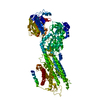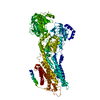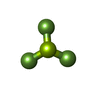+ データを開く
データを開く
- 基本情報
基本情報
| 登録情報 | データベース: PDB / ID: 7w7v | |||||||||||||||
|---|---|---|---|---|---|---|---|---|---|---|---|---|---|---|---|---|
| タイトル | 'late' E2P of SERCA2b | |||||||||||||||
 要素 要素 | Sarcoplasmic/endoplasmic reticulum calcium ATPase 2 | |||||||||||||||
 キーワード キーワード | METAL TRANSPORT / calcium | |||||||||||||||
| 機能・相同性 |  機能・相同性情報 機能・相同性情報ER-nucleus signaling pathway / longitudinal sarcoplasmic reticulum / positive regulation of endoplasmic reticulum calcium ion concentration / regulation of calcium ion-dependent exocytosis of neurotransmitter / calcium ion transport from cytosol to endoplasmic reticulum / P-type calcium transporter activity involved in regulation of cardiac muscle cell membrane potential / calcium ion-transporting ATPase complex / T-tubule organization / regulation of cardiac muscle cell action potential involved in regulation of contraction / regulation of cardiac muscle cell membrane potential ...ER-nucleus signaling pathway / longitudinal sarcoplasmic reticulum / positive regulation of endoplasmic reticulum calcium ion concentration / regulation of calcium ion-dependent exocytosis of neurotransmitter / calcium ion transport from cytosol to endoplasmic reticulum / P-type calcium transporter activity involved in regulation of cardiac muscle cell membrane potential / calcium ion-transporting ATPase complex / T-tubule organization / regulation of cardiac muscle cell action potential involved in regulation of contraction / regulation of cardiac muscle cell membrane potential / ribbon synapse / platelet dense tubular network membrane / calcium ion import into sarcoplasmic reticulum / Pre-NOTCH Processing in Golgi / P-type Ca2+ transporter / sarcoplasmic reticulum calcium ion transport / negative regulation of heart contraction / transition between fast and slow fiber / P-type calcium transporter activity / regulation of the force of heart contraction / endoplasmic reticulum calcium ion homeostasis / cardiac muscle hypertrophy in response to stress / regulation of cardiac muscle contraction by calcium ion signaling / S100 protein binding / relaxation of cardiac muscle / Reduction of cytosolic Ca++ levels / lncRNA binding / organelle localization by membrane tethering / autophagosome membrane docking / mitochondrion-endoplasmic reticulum membrane tethering / positive regulation of heart rate / positive regulation of cardiac muscle cell apoptotic process / Ion transport by P-type ATPases / autophagosome assembly / regulation of cardiac conduction / epidermis development / Ion homeostasis / sarcoplasmic reticulum membrane / response to endoplasmic reticulum stress / negative regulation of receptor binding / sarcoplasmic reticulum / calcium ion transmembrane transport / intracellular calcium ion homeostasis / neuron cellular homeostasis / cellular response to oxidative stress / monoatomic ion transmembrane transport / transmembrane transporter binding / cell adhesion / calcium ion binding / endoplasmic reticulum membrane / enzyme binding / endoplasmic reticulum / ATP hydrolysis activity / ATP binding / membrane / plasma membrane 類似検索 - 分子機能 | |||||||||||||||
| 生物種 |  Homo sapiens (ヒト) Homo sapiens (ヒト) | |||||||||||||||
| 手法 | 電子顕微鏡法 / 単粒子再構成法 / クライオ電子顕微鏡法 / 解像度: 3 Å | |||||||||||||||
 データ登録者 データ登録者 | Zhang, Y. / Watanabe, S. / Tsutsumi, A. / Inaba, K. | |||||||||||||||
| 資金援助 |  日本, 4件 日本, 4件
| |||||||||||||||
 引用 引用 |  ジャーナル: Cell Rep / 年: 2022 ジャーナル: Cell Rep / 年: 2022タイトル: Multiple sub-state structures of SERCA2b reveal conformational overlap at transition steps during the catalytic cycle. 著者: Yuxia Zhang / Chigusa Kobayashi / Xiaohan Cai / Satoshi Watanabe / Akihisa Tsutsumi / Masahide Kikkawa / Yuji Sugita / Kenji Inaba /  要旨: Sarco/endoplasmic reticulum Ca ATPase (SERCA) pumps Ca into the endoplasmic reticulum (ER). Herein, we present cryo-electron microscopy (EM) structures of three intermediates of SERCA2b: Ca-bound ...Sarco/endoplasmic reticulum Ca ATPase (SERCA) pumps Ca into the endoplasmic reticulum (ER). Herein, we present cryo-electron microscopy (EM) structures of three intermediates of SERCA2b: Ca-bound phosphorylated (E1P·2Ca) and Ca-unbound dephosphorylated (E2·Pi) intermediates and another between the E2P and E2·Pi states. Our cryo-EM analysis demonstrates that the E1P·2Ca state exists in low abundance and preferentially transitions to an E2P-like structure by releasing Ca and that the Ca release gate subsequently undergoes stepwise closure during the dephosphorylation processes. Importantly, each intermediate adopts multiple sub-state structures including those like the next one in the catalytic series, indicating conformational overlap at transition steps, as further substantiated by atomistic molecular dynamic simulations of SERCA2b in a lipid bilayer. The present findings provide insight into how enzymes accelerate catalytic cycles. #1:  ジャーナル: EMBO J / 年: 2021 ジャーナル: EMBO J / 年: 2021タイトル: Cryo-EM analysis provides new mechanistic insight into ATP binding to Ca -ATPase SERCA2b. 著者: Yuxia Zhang / Satoshi Watanabe / Akihisa Tsutsumi / Hiroshi Kadokura / Masahide Kikkawa / Kenji Inaba /  要旨: Sarco/endoplasmic reticulum Ca -ATPase (SERCA) 2b is a ubiquitous SERCA family member that conducts Ca uptake from the cytosol to the ER. Herein, we present a 3.3 Å resolution cryo-electron ...Sarco/endoplasmic reticulum Ca -ATPase (SERCA) 2b is a ubiquitous SERCA family member that conducts Ca uptake from the cytosol to the ER. Herein, we present a 3.3 Å resolution cryo-electron microscopy (cryo-EM) structure of human SERCA2b in the E1·2Ca state, revealing a new conformation for Ca -bound SERCA2b with a much closer arrangement of cytosolic domains than in the previously reported crystal structure of Ca -bound SERCA1a. Multiple conformations generated by 3D classification of cryo-EM maps reflect the intrinsically dynamic nature of the cytosolic domains in this state. Notably, ATP binding residues of SERCA2b in the E1·2Ca state are located at similar positions to those in the E1·2Ca -ATP state; hence, the cryo-EM structure likely represents a preformed state immediately prior to ATP binding. Consistently, a SERCA2b mutant with an interdomain disulfide bridge that locks the closed cytosolic domain arrangement displayed significant autophosphorylation activity in the presence of Ca . We propose a novel mechanism of ATP binding to SERCA2b. | |||||||||||||||
| 履歴 |
|
- 構造の表示
構造の表示
| 構造ビューア | 分子:  Molmil Molmil Jmol/JSmol Jmol/JSmol |
|---|
- ダウンロードとリンク
ダウンロードとリンク
- ダウンロード
ダウンロード
| PDBx/mmCIF形式 |  7w7v.cif.gz 7w7v.cif.gz | 185.7 KB | 表示 |  PDBx/mmCIF形式 PDBx/mmCIF形式 |
|---|---|---|---|---|
| PDB形式 |  pdb7w7v.ent.gz pdb7w7v.ent.gz | 144.3 KB | 表示 |  PDB形式 PDB形式 |
| PDBx/mmJSON形式 |  7w7v.json.gz 7w7v.json.gz | ツリー表示 |  PDBx/mmJSON形式 PDBx/mmJSON形式 | |
| その他 |  その他のダウンロード その他のダウンロード |
-検証レポート
| 文書・要旨 |  7w7v_validation.pdf.gz 7w7v_validation.pdf.gz | 1022.9 KB | 表示 |  wwPDB検証レポート wwPDB検証レポート |
|---|---|---|---|---|
| 文書・詳細版 |  7w7v_full_validation.pdf.gz 7w7v_full_validation.pdf.gz | 1 MB | 表示 | |
| XML形式データ |  7w7v_validation.xml.gz 7w7v_validation.xml.gz | 37.6 KB | 表示 | |
| CIF形式データ |  7w7v_validation.cif.gz 7w7v_validation.cif.gz | 56.7 KB | 表示 | |
| アーカイブディレクトリ |  https://data.pdbj.org/pub/pdb/validation_reports/w7/7w7v https://data.pdbj.org/pub/pdb/validation_reports/w7/7w7v ftp://data.pdbj.org/pub/pdb/validation_reports/w7/7w7v ftp://data.pdbj.org/pub/pdb/validation_reports/w7/7w7v | HTTPS FTP |
-関連構造データ
- リンク
リンク
- 集合体
集合体
| 登録構造単位 | 
|
|---|---|
| 1 |
|
- 要素
要素
| #1: タンパク質 | 分子量: 114869.664 Da / 分子数: 1 / 由来タイプ: 組換発現 / 由来: (組換発現)  Homo sapiens (ヒト) / 遺伝子: ATP2A2, ATP2B / 発現宿主: Homo sapiens (ヒト) / 遺伝子: ATP2A2, ATP2B / 発現宿主:  Homo sapiens (ヒト) / 参照: UniProt: P16615, P-type Ca2+ transporter Homo sapiens (ヒト) / 参照: UniProt: P16615, P-type Ca2+ transporter |
|---|---|
| #2: 化合物 | ChemComp-BEF / |
| #3: 化合物 | ChemComp-MG / |
| 研究の焦点であるリガンドがあるか | Y |
-実験情報
-実験
| 実験 | 手法: 電子顕微鏡法 |
|---|---|
| EM実験 | 試料の集合状態: PARTICLE / 3次元再構成法: 単粒子再構成法 |
- 試料調製
試料調製
| 構成要素 | 名称: SERCA2b with Ca / タイプ: COMPLEX / Entity ID: #1 / 由来: RECOMBINANT |
|---|---|
| 分子量 | 値: 110 kDa/nm / 実験値: NO |
| 由来(天然) | 生物種:  Homo sapiens (ヒト) Homo sapiens (ヒト) |
| 由来(組換発現) | 生物種:  Homo sapiens (ヒト) Homo sapiens (ヒト) |
| 緩衝液 | pH: 7 |
| 試料 | 包埋: NO / シャドウイング: NO / 染色: NO / 凍結: YES |
| 急速凍結 | 凍結剤: ETHANE |
- 電子顕微鏡撮影
電子顕微鏡撮影
| 実験機器 |  モデル: Titan Krios / 画像提供: FEI Company |
|---|---|
| 顕微鏡 | モデル: FEI TITAN KRIOS |
| 電子銃 | 電子線源:  FIELD EMISSION GUN / 加速電圧: 300 kV / 照射モード: OTHER FIELD EMISSION GUN / 加速電圧: 300 kV / 照射モード: OTHER |
| 電子レンズ | モード: BRIGHT FIELD |
| 撮影 | 電子線照射量: 60 e/Å2 フィルム・検出器のモデル: GATAN K3 BIOQUANTUM (6k x 4k) |
- 解析
解析
| ソフトウェア | 名称: PHENIX / バージョン: 1.18.2_3874: / 分類: 精密化 | ||||||||||||||||||||||||
|---|---|---|---|---|---|---|---|---|---|---|---|---|---|---|---|---|---|---|---|---|---|---|---|---|---|
| CTF補正 | タイプ: NONE | ||||||||||||||||||||||||
| 3次元再構成 | 解像度: 3 Å / 解像度の算出法: FSC 0.143 CUT-OFF / 粒子像の数: 183700 / 対称性のタイプ: POINT | ||||||||||||||||||||||||
| 拘束条件 |
|
 ムービー
ムービー コントローラー
コントローラー










 PDBj
PDBj












